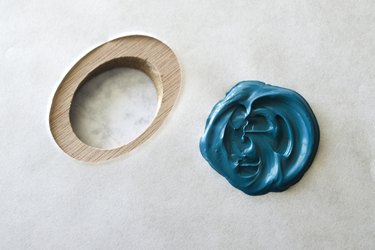
The soothing shades of turquoise that you see in jewelry, art and even the walls of your home vary not just in the mixture of blue, green, white and sometimes a dash of yellow or red but in the way that you perceive color. Turquoise can lean toward green or blue depending on your decor or artistic needs. No matter how you mix your favorite turquoise, be sure to make enough to finish the project.
The Elements of Turquoise
Video of the Day
There are three ways to look at color. The RGB, or additive color system, used by scientists and in electronics; the subtractive color system used by artists and painters; and the CMYK color system, which is used in printing. Scientists use light to create color, while artists use paint. Unlike the RGB and subtractive systems, the CMYK system uses tiny dots of pure color – cyan, magenta, yellow and black – which the eye translates to many shades and hues of color.
Video of the Day
When preparing paint colors, you use the subtractive color system to produce the perfect shade for your art or wall. The familiar primary colors of blue, red and yellow are combined to make secondary colors such as green, orange and purple. Turquoise is a tertiary color that is produced by mixing blue and green. Add a little white to lighten the turquoise, a pinch of yellow to bring out the green hue, a little black to deepen the shade or a drop of red to soften the tone.
Mixing Turquoise House Paint
You can mix your own turquoise tint using a light, medium or deep base. While you can use an oil or latex paint, the water-based latex is easy to clean with soap and water and has fewer volatile organic compounds to irritate your sinuses and lungs. Whether you use an oil-based or water-based paint, select a matching colorant – oil to oil and water to water.
A light or pastel base has more white pigment, while a medium base has less white pigment and a deep or ultra base has very little pigment, making it nearly transparent. The light base covers the wall better and may only need one or two coats. Even after adding the colorant, the dark base will need multiple coats to adequately cover the wall in a solid, deep color. Also, paint dries lighter than it appears in the can, so paint a test swatch before painting an accent wall or the entire room.
To add color to your base, pour the paint into a 5-gallon bucket. Add your colorant, which may be oil or acrylic paint or a commercial colorant made for tinting house paints. Start with a few drops of blue and green in equal parts and then add a little more blue or green to make it just the right tint. You can also add a drop or two of yellow or red to brighten or soften the tone. Mix with a stick or a paint mixer attached to your electric drill.
Making Turquoise Paint for Art
Watercolors, acrylics and oils are all mixed in a similar manner. Begin by squeezing blue and green paint onto your palette in a 2-to-1 ratio and then add more blue or green to find the right color. It is easier to reach a clear, bright turquoise by starting with a blue that already leans toward the green side, such as a cerulean or cobalt blue.
Alternatively, for intense but more transparent colors, combine phthalo blue with sap or viridian green, cobalt blue with phthalo green or phthalo blue with phthalo green. Add titanium white to lighten your turquoise or alizarin crimson to deepen the shade.
Once you've reached the perfect turquoise color for your painting, you can paint it in swaths across the paper or canvas or apply it in thin layers to add depth to the image. Depending on whether you're using watercolor, acrylic or oil paints, mix the turquoise and other colors with water, acrylic medium or linseed oil to make transparent washes or glazes. Multiple layers intensify the color little by little, letting you add shadows or highlights to your subject without muddying the color.
- Durango Silver Company: Turquoise Color Examples
- Color Matters: Color Systems - RGB & CMYK
- House Painting Tutorials: The ABC's of Mixing Paint Colors
- Bob Vila: All You Need to Know About Paint Types
- Andrew Pugach: Mixing Paint Colors
- Artists Network: 2 Ways to Thin Acrylic Paint | Painting with Acrylics for Beginners
- Golden Paints: Color Mixing Guide